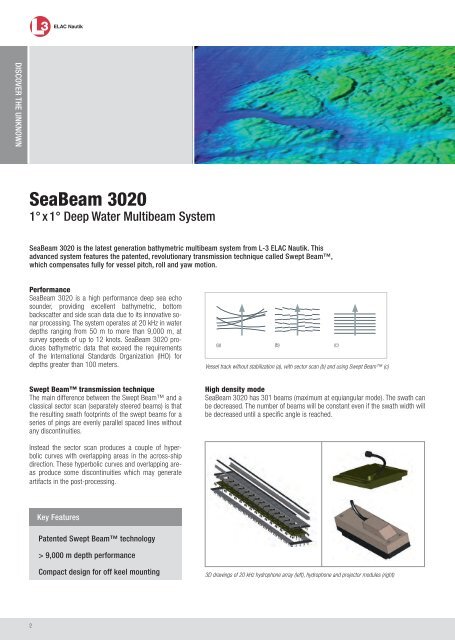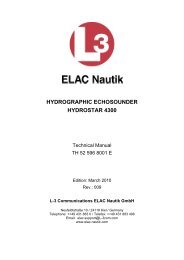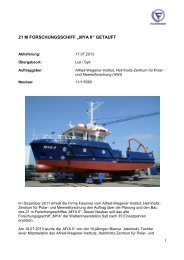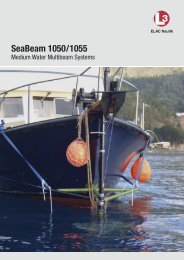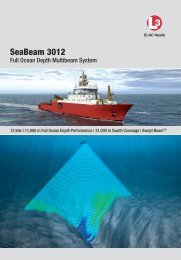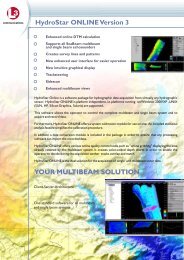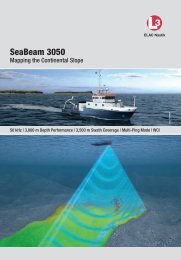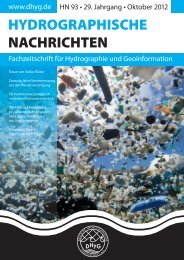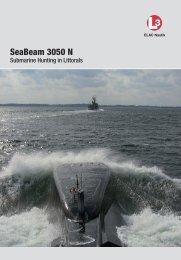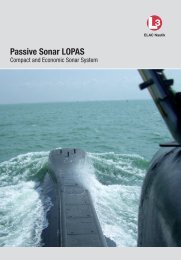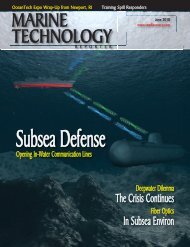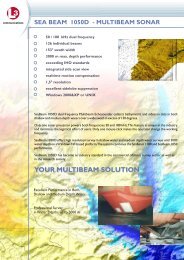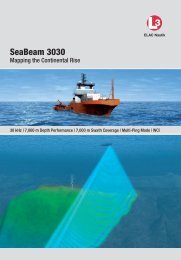SeaBeam 3020 - Elac-Nautik
SeaBeam 3020 - Elac-Nautik
SeaBeam 3020 - Elac-Nautik
Create successful ePaper yourself
Turn your PDF publications into a flip-book with our unique Google optimized e-Paper software.
DISCOVER THE UNKNOWN<br />
<strong>SeaBeam</strong> <strong>3020</strong><br />
1° x 1° Deep Water Multibeam System<br />
<strong>SeaBeam</strong> <strong>3020</strong> is the latest generation bathymetric multibeam system from L-3 ELAC <strong>Nautik</strong>. This<br />
advanced system features the patented, revolutionary transmission technique called Swept Beam,<br />
which compensates fully for vessel pitch, roll and yaw motion.<br />
Performance<br />
<strong>SeaBeam</strong> <strong>3020</strong> is a high performance deep sea echo<br />
sounder, providing excellent bathymetric, bottom<br />
backscatter and side scan data due to its innovative sonar<br />
processing. The system operates at 20 kHz in water<br />
depths ranging from 50 m to more than 9,000 m, at<br />
survey speeds of up to 12 knots. <strong>SeaBeam</strong> <strong>3020</strong> produces<br />
bathymetric data that exceed the requirements<br />
of the International Standards Organization (IHO) for<br />
depths greater than 100 meters.<br />
(a)<br />
(b)<br />
(c)<br />
Vessel track without stabilization (a), with sector scan (b) and using Swept Beam (c)<br />
Swept Beam transmission technique<br />
The main difference between the Swept Beam and a<br />
classical sector scan (separately steered beams) is that<br />
the resulting swath footprints of the swept beams for a<br />
series of pings are evenly parallel spaced lines without<br />
any discontinuities.<br />
High density mode<br />
<strong>SeaBeam</strong> <strong>3020</strong> has 301 beams (maximum at equiangular mode). The swath can<br />
be decreased. The number of beams will be constant even if the swath width will<br />
be decreased until a specific angle is reached.<br />
Instead the sector scan produces a couple of hyperbolic<br />
curves with overlapping areas in the across-ship<br />
direction. These hyperbolic curves and overlapping areas<br />
produce some discontinuities which may generate<br />
artifacts in the post-processing.<br />
Key Features<br />
Patented Swept Beam technology<br />
> 9,000 m depth performance<br />
Compact design for off keel mounting<br />
3D drawings of 20 kHz hydrophone array (left), hydrophone and projector modules (right)<br />
2


